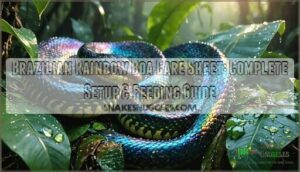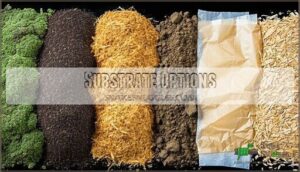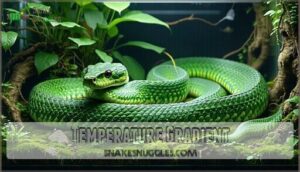This site is supported by our readers. We may earn a commission, at no cost to you, if you purchase through links.

You’ll handle them confidently by supporting their muscular bodies and respecting their nocturnal nature. With proper veterinary care and routine maintenance, these iridescent beauties can be your companions for up to 20 years.
The secret to their rainbow shimmer lies in understanding their unique environmental needs.
Table Of Contents
- Key Takeaways
- Overview of Brazilian Rainbow Boa
- Brazilian Rainbow Boa Care Requirements
- Housing and Habitat Essentials
- Temperature, Humidity, and Lighting Needs
- Feeding and Hydration Guidelines
- Handling and Safety Precautions
- Health, Behavior, and Maintenance Tips
- Frequently Asked Questions (FAQs)
- What is the Brazilian rainbow boa care sheet?
- How do I care for a Brazilian rainbow boa?
- Do Brazilian rainbow boas need a big aquarium?
- How much humidity do Brazilian rainbow boas need?
- Are Brazilian rainbow boas healthy?
- Are rainbow boas easy to keep?
- Are Brazilian rainbow boas hard to care for?
- What is the best bedding for a Brazilian rainbow boa?
- Are Brazilian rainbow boas good for beginners?
- What do I need for a rainbow boa?
- Conclusion
Key Takeaways
- You’ll need to maintain precise environmental conditions with temperatures of 75-85°F and humidity levels of 75-90% to prevent respiratory infections and shedding problems.
- Your adult boa requires a minimum 6’x3’x3′ enclosure with proper substrate, climbing branches, and a large water bowl for soaking and humidity control.
- You should feed frozen-thawed rodents weekly for juveniles and every 2-4 weeks for adults, sizing prey to match your snake’s thickest body section.
- You can expect 20+ years of companionship when you provide consistent care, regular veterinary check-ups, and handle your boa confidently with proper body support.
Overview of Brazilian Rainbow Boa
You’ll find Brazilian rainbow boas are stunning constrictor snakes that reach 5-6.5 feet long, known for their mesmerizing oil slick-like iridescence and distinctive black ring patterns on orange-red scales.
These Amazon Basin natives make intermediate-level pets with their docile temperament, though they’ll need your commitment for up to 20 years of proper care.
Origin and Habitat
Your Brazilian rainbow boa’s homeland spans South America’s Amazon Basin and Guiana Shield regions. These snakes are native to Brazil, Peru, Colombia, and Suriname, where they’ve adapted to dense rainforest conditions. Understanding their natural habitat helps you recreate proper captive environments that support their instinctive behaviors.
Boa constrictors also thrive in savannas and grasslands, showcasing their adaptability to different environments.
- Amazon River Basin environments provide the high humidity and warm temperatures your boa needs
- Native countries’ climates feature consistent moisture levels that prevent shedding problems
- Natural behavior patterns include nocturnal hunting and arboreal movement through dense vegetation
Physical Characteristics
You’ll be amazed by your Brazilian Rainbow Boa’s stunning appearance. These serpents showcase iridescent scales that shimmer like oil slicks, creating their signature rainbow effect.
Adults reach an average size of 5-6.5 feet in body length, while neonates start around 12-18 inches. Their distinctive head shape features a long, tapered design with a blunt snout. Notice their vertical pupils and specialized heat pits along the lips for detecting warm-blooded prey.
The base coloration ranges from orange to deep red with distinctive black rings creating beautiful patterns across their slender, muscular bodies.
Lifespan
Your Brazilian Rainbow Boa’s lifespan usually reaches 20-25 years in captivity, though Maximum Age can exceed this with proper care. Longevity Factors include quality diet, stable temperatures, and appropriate humidity levels.
Genetic Influence plays a role, but Captivity Impact proves significant – wild specimens face more challenges.
With dedication to their complex needs, you’ll enjoy decades with your iridescent companion. Proper husbandry directly affects their End-of-Life timing.
Temperament
You’ll find these snakes have a docile nature once settled, though individual variation means some show more defensive behaviors than others. Their temperament shifts from skittish juveniles to calmer adults, making Brazilian Rainbow Boa behavior predictable with patience and respect.
Handling ease improves with consistent taming techniques – they rarely bite when properly supported.
Brazilian Rainbow Boa Care Requirements
Setting up proper Brazilian Rainbow Boa Care Requirements isn’t rocket science, but you’ll need to juggle several moving pieces like a circus performer. These gorgeous serpents demand specific temperature and humidity levels that mirror their Amazon roots. Your snake won’t thrive without maintaining consistent heating requirements that create proper thermal gradients.
Key care components include:
- Enclosure Size: Adults need minimum 6’L x 3’W x 3’H to stretch and explore comfortably
- Enclosure Sanitation: Weekly spot cleaning and monthly deep cleaning prevent harmful bacteria buildup
- Dietary Variety: Rodent-based diet with appropriate sizing prevents nutrition deficiencies
- Veterinary Visits: Annual check-ups help catch health issues early
Temperament concerns rarely arise since these boas are generally docile. However, shedding problems can occur without proper humidity requirements (75-90% consistently). Watch for incomplete sheds that signal environmental issues. Remember, consistent routines are also vital for their well-being. Remember, consistency beats flawlessness – your boa needs stable conditions rather than constantly fluctuating parameters.
Housing and Habitat Essentials
You’ll need to create a proper home that mimics your Brazilian rainbow boa’s natural Amazon environment, complete with the right enclosure size, substrate, and environmental controls.
Getting the housing fundamentals right from the start prevents most health problems and ensures your snake can display natural behaviors like climbing and soaking.
Enclosure Size and Type
When choosing your Brazilian Rainbow Boa’s home, think bigger than you’d expect. These snakes need generous Enclosure Dimensions—minimum 6’L x 3’W x 3’H for adults. Tank Material matters: PVC or sealed wood retains humidity better than glass.
Consider these Cage Requirements:
- Custom Enclosures with front-opening doors for easy access
- Vertical Space for climbing branches and environmental enrichment
- Security Features like secure latches and escape-proof ventilation
- Proper airflow without creating drafts that drop humidity
- Easy-clean surfaces for maintenance and snake health
Your Brazilian Rainbow Boa Housing Needs demand space to stretch, climb, and thermoregulate properly.
Substrate Options
Your Brazilian Rainbow Boa needs a proper substrate depth of 4 inches for ideal humidity retention. Naturalistic substrates work best—try mixing 60% topsoil with 40% coconut fiber. This substrate mixture holds moisture like a champ while allowing good drainage.
You’ll find cleaning frequency matters too; spot-clean weekly and replace monthly. Consider buying quality substrate for your boa. **Quality tank bedding keeps your snake healthy and comfortable.
**
Enrichment Items and Decorations
Your rainbow boa needs climbing branches and varied hides for security. Add a cork bark tube and water features for natural décor ideas.
Live plants boost your enclosure while improving air quality. Consider backgrounds/artwork to create visual depth.
Providing appropriate reptile habitat features is vital for their well-being. These décor elements transform basic substrate options into an engaging habitat that encourages natural behaviors and reduces stress.
Temperature and Humidity Control
Your Brazilian Rainbow Boa’s wellbeing hinges on precise Temperature and Humidity control. Use these heating methods to create proper gradient importance:
- Heating Methods: Install overhead halogen bulbs for basking spots at 86-90°F, never hot rocks
- Humidity Monitoring: Maintain 75-90% humidity with digital hygrometers and daily misting
- Seasonal Adjustments: Boost humidity during shedding issues to prevent incomplete sheds
Temperature and lighting work together – your basking area needs that sweet spot while cool zones stay 72-75°F.
Maintaining proper enclosure hygiene is also critical to prevent health issues. Brazilian Rainbow Boa temperature requirements aren’t negotiable. Proper humidity levels prevent respiratory problems and shedding disasters.
Temperature, Humidity, and Lighting Needs
You’ll need to create the right environmental conditions to keep your Brazilian rainbow boa healthy, which means getting the temperature gradient, humidity levels, and lighting setup just right.
Think of it as building a mini Amazon rainforest in your home—your snake’s health depends on nailing these three critical factors that work together like a perfectly balanced ecosystem.
Temperature Gradient
Your Brazilian Rainbow Boa needs proper ambient temperature zones to thrive. Think of it like creating climate zones in your living room – each area has a purpose.
- Warm side: Maintain 80-85°F with reliable heat source and thermostat control
- Cool side: Keep at 78-80°F for temperature regulation
- Nighttime drop: Allow tank temperature to decrease 3-5°F naturally
Monitor consistently: Check Brazilian Rainbow Boa temperature daily for ideal health. Consistent monitoring helps prevent shedding and dry skin.
Basking Spot
Your Brazilian Rainbow Boa needs a proper basking area to thermoregulate effectively. Create this warm zone using ceramic heat emitters or halogen bulbs positioned 12-15 inches above sturdy branches. The basking temperature range should hit 86-90°F consistently. Alternative heat sources like under-tank heaters work too, but overhead heating mimics natural conditions better. Always use thermostat control to prevent overheating accidents.
| Heat Source | Distance | Temperature | Safety Notes |
|---|---|---|---|
| Halogen Bulb | 12-15 inches | 86-90°F | Guard required |
| Ceramic Heater | 10-12 inches | 86-90°F | No light emission |
| Under-tank | Direct contact | 85-88°F | Thermostat needed |
| Heat Panel | 8-10 inches | 86-90°F | Even heat spread |
Choose ideal branch material like cork bark or sturdy hardwood for your basking platform.
UVB Lighting
Your boa’s health gets a real boost with proper UVB lighting. While not essential for survival, UVB benefits include stronger immune function and better calcium absorption.
Choose a 5-6% Ideal Spectrum bulb like Zoo Med ReptiSun or Arcadia Forest brands for brand comparison. Position the bulb distance at 8-12 inches from your Brazilian Rainbow Boa’s basking spot in the enclosure.
Run your lighting schedule for 12 hours daily to maintain natural rhythms. UVB enhances temperature and lighting balance, promoting healthier behavior patterns. Boa constrictors benefit from consistent photoperiods to regulate their day-night cycle.
Humidity Levels and Maintenance
Getting your Brazilian Rainbow Boa’s humidity right prevents shedding issues and keeps your snake healthy. These snakes need 75-90% humidity levels, which requires daily attention and proper monitoring techniques.
- Install dual hygrometers for accurate humidity monitoring across the enclosure
- Mist daily using distilled water to boost humidity without mineral buildup
- Add humid hides with damp sphagnum moss to create microclimates for shedding
- Make certain proper ventilation to prevent mold while maintaining Brazilian Rainbow Boa humidity levels
Feeding and Hydration Guidelines
You’ll need to establish a proper feeding schedule and maintain fresh water to keep your Brazilian rainbow boa healthy and thriving. Getting the prey size right prevents digestive issues, while clean water promotes both drinking needs and the humidity levels these snakes require.
Neonate and Adult Diet
Your boa’s diet changes substantially as it grows. Newborns thrive on pinky mice or hoppers, feeding weekly for ideal growth. Adult Brazilian rainbow boas need medium rats every two to four weeks.
Prey variety like quail or chicks prevents nutritional gaps, while frozen-thawed rodents stay safest.
Monitor feeding frequency carefully—overfeeding leads to obesity, while supplementation needs vary based on prey diversity and health requirements.
Feeding Frequency and Prey Size
Every successful Brazilian Rainbow Boa Feeding And Diet relies on proper timing and sizing. Prey Size: Match prey width to your snake’s thickest point—no larger.
Feeding Schedule: Juveniles need weekly meals; adults thrive on bi-weekly Feeding Frequency. This Preferred Food approach prevents Overfeeding Risks while ensuring adequate Prey Nutritional Value. Smart Feeding practices mean healthier snakes.
Hydration and Water Quality
Water Bowl Size matters—choose one large enough for your Brazilian Rainbow Boa to soak completely. Change fresh water daily to prevent bacteria buildup.
Dehydration Signs include wrinkled skin and lethargy. Your Water Source should be dechlorinated.
Proper Hydration aids Shedding Assistance by maintaining ideal Humidity levels, keeping your snake healthy and comfortable.
Handling and Safety Precautions
You’ll need to handle your Brazilian rainbow boa with confidence and proper technique, as these strong constrictors can be surprisingly quick when startled.
Remember that even docile snakes can bite if they feel threatened, so always support their body weight with both hands and move slowly to avoid triggering their natural defensive responses.
Support and Handling Techniques
When handling your Brazilian Rainbow Boa, proper support makes all the difference for safe handling. These snakes respond well to confident, gentle techniques that respect their temperament and natural behavior.
Key support techniques for Handling Your Brazilian Rainbow Boa:
- Use both hands – Support the body at two points for proper support
- Move slowly – Sudden movements trigger defensive responses, affecting bite prevention
- Support the weight – Never let sections dangle unsupported for reducing stress
Quality handling tools like padded gloves can boost your confidence initially. Remember, consistent gentle interaction builds trust and improves your Brazilian Rainbow Boa temperament and handling experience over time.
Safety Considerations
Now that you’ve mastered proper handling techniques, let’s focus on keeping everyone safe. Bite prevention starts with reading your boa’s body language—tense coils mean back off. Always secure enclosure latches for escape prevention. Wash hands thoroughly after handling to avoid salmonella risk and guarantee child safety around your snake.
| Safety Area | Key Precaution | Why It Matters |
|---|---|---|
| Bite Prevention | Watch for defensive posturing | Prevents injury and stress |
| Escape Prevention | Check all enclosure locks | Keeps your boa secure |
| Sanitation | Wash hands after handling | Reduces salmonella risk |
| Child Safety | Supervise all interactions | Protects kids from boa constriction |
| Health Issues | Monitor for signs of illness | Early detection prevents serious problems |
Handling Frequency and Duration
Your Brazilian rainbow boa thrives with consistent, gentle handling sessions. Here’s your approach to Building Trust safely:
- Ideal Session Length: Keep interactions to 15-20 minutes maximum – longer sessions create unnecessary Handling Stress Signs
- Frequency matters: Handle 2-3 times weekly, watching for defensive posturing or rapid breathing that signals stress
- Post-Handling Care: Always return your snake gently to its enclosure, avoiding sudden movements that could trigger Avoiding Bites responses
Smart Behavior observation and proper Rainbow Boa Care make handling enjoyable for both you and your snake.
Health, Behavior, and Maintenance Tips
You’ll need to monitor your rainbow boa’s health closely, as these snakes are excellent at hiding illness until it becomes serious. Regular observation of eating habits, shedding cycles, and behavioral changes will help you catch potential problems early and keep your snake thriving for its full 20-year lifespan.
Common Health Issues
Keep your boa healthy by watching for these Brazilian Rainbow Boa Health Issues. Respiratory Infections develop when humidity drops too low or temperatures fluctuate. Shedding Problems occur if humidity stays below seventy percent. Scale Rot happens from dirty, wet substrate. Proper Parasite Control prevents mites and internal worms.
- Respiratory conditions – wheezing, mouth breathing from poor humidity
- Skin conditions – incomplete sheds, stuck eye caps from dry air
- Scale Rot – blisters from wet substrate, poor ventilation
- Obesity Prevention – avoid overfeeding for long-term health
Behavioral Patterns
Three key aspects define your Brazilian rainbow boa’s behavior in captivity. Activity Cycles show these nocturnal hunters becoming most active during evening hours, mirroring their natural Hunting Strategies. Social Interactions remain minimal since these snakes prefer solitude in their habitat. Understanding Defensive Behaviors helps you recognize when your boa feels threatened—watch for sudden hissing or striking motions. Captive Adaptations allow them to adjust their sleeping habits and eating habits to your schedule over time. Creating a calm environment fosters healthy behavioral patterns and reduces stress.
Shedding and Skin Care
Understanding your rainbow boa’s shedding process helps you provide better care during this vulnerable time. Adult boas shed every few months, while juveniles molt more frequently as they grow rapidly.
Watch for these shedding signs and respond appropriately:
- Pre-shed indicators: Eyes turn milky blue, skin becomes dull, and your snake may refuse food for several days
- Humidity management: Boost levels to 85-90% through misting techniques to prevent retained shed complications
- Post-shed inspection: Check for stuck pieces, especially around the tail tip and eye caps, which can cause skin infections
Shedding problems often stem from low humidity effects, so maintain consistent moisture levels throughout the shedding cycle for ideal skin health.
Veterinary Care and Check-Ups
Your boa needs annual exams from a reptile veterinarian to catch health issues early. These visits screen for internal parasites, respiratory infections, and skin conditions while reviewing your setup.
Quarantine protocols matter when adding new reptiles—isolation prevents disease spread. Watch for breathing problems, unusual lumps, or prolapses that need immediate attention.
Monitoring activity levels can provide insights into your boa’s well-being. Preventing illness beats treating it later.
Frequently Asked Questions (FAQs)
What is the Brazilian rainbow boa care sheet?
You’ll need a 6′ x 3′ x 3′ enclosure with 75-90% humidity, 86-90°F basking spot, UVB lighting, and substrate for burrowing.
Feed frozen-thawed rodents every 1-2 weeks for juveniles, 2-4 weeks for adults.
How do I care for a Brazilian rainbow boa?
You’ll need proper heat gradients, high humidity levels, and spacious enclosures for your rainbow boa.
Maintain 86-90°F basking spots with 75-90% humidity through daily misting.
Feed appropriately-sized frozen-thawed rodents every 1-4 weeks depending on age.
Do Brazilian rainbow boas need a big aquarium?
Yes, you’ll need a spacious enclosure for your adult Brazilian rainbow boa. They require at least a 75-90 gallon tank, with 6’L x 3’W x 3’H being the recommended minimum size for proper movement and comfort.
How much humidity do Brazilian rainbow boas need?
Like telegraphing morse code, you’ll need consistent high humidity levels for your rainbow boa’s health. Maintain 75-90% humidity through daily misting, with nighttime levels reaching 90-100% for ideal shedding and respiratory function.
Are Brazilian rainbow boas healthy?
Usually, you’ll find these snakes are remarkably hardy creatures with no major genetic health issues. Most problems stem from poor husbandry—wrong temperatures or humidity levels can spell trouble for your scaled friend.
Are rainbow boas easy to keep?
Despite their stunning beauty, rainbow boas aren’t beginners’ snakes. You’ll need intermediate experience handling humidity requirements (75-90%), temperature gradients, and their defensive temperament when stressed.
Are Brazilian rainbow boas hard to care for?
Brazilian rainbow boas aren’t particularly difficult, but they’re not beginner snakes either. **You’ll need to maintain strict humidity levels around 75-90% and provide proper temperature gradients.
**
Their care requirements are manageable with experience.
What is the best bedding for a Brazilian rainbow boa?
You’ll want a deep substrate mix that holds humidity well. Mix 60% topsoil with 40% coconut fiber, keeping it 4 inches deep.
Top with clean leaf litter for a natural rainforest feel your boa craves.
Are Brazilian rainbow boas good for beginners?
Think you’re ready to jump into rainbow boa ownership? These stunning snakes aren’t beginner-friendly pets.
You’ll need intermediate-level experience with reptiles, precise humidity control, and patience for their complex environmental needs.
What do I need for a rainbow boa?
You’ll need a 6’x3’x3′ enclosure with proper heating (86-90°F basking spot), UVB lighting, and high humidity (75-90%).
Include a substrate for burrowing, hiding spots, climbing branches, and a large water bowl for soaking.
Conclusion
Success with your Brazilian rainbow boa care sheet comes down to one timeless truth: "An ounce of prevention is worth a pound of cure." Consistent environmental monitoring prevents most health issues before they start.
These stunning serpents reward dedicated keepers with decades of companionship when you maintain proper temperatures, humidity, and feeding schedules. **Remember, your attention to detail today determines your snake’s health tomorrow.
**
- https://coldblooded.com/read-blog/63_care-guide-boas-brazilian-rainbow-boas.html
- https://www.petmd.com/reptile/brazilian-rainbow-boa-care-sheet
- https://reptilesmagazine.com/rainbow-boa-care-sheet/
- https://allanspetcenter.com/how-to-care-for-your-brazilian-rainbow-boa/
- https://www.galapagospet.com/animals/brazilian-rainbow-boa/


















